Forest Carbon Storage Dynamics and Influencing Factors in Southeastern Tibet: GEE and Machine Learning Analysis
Abstract
1. Introduction
2. Study Area
3. Material and Methods
3.1. Data Source
3.1.1. Landsat 8 Data
3.1.2. Sentinel-1 Data
3.1.3. ERA5 Meteorological Data
3.1.4. GEDI Data
3.1.5. SRTM Data
3.1.6. ESA Data
3.2. Research Methods
3.2.1. Machine Learning Algorithms
3.2.2. Model Implementation
3.2.3. Evaluation Metrics
3.2.4. Carbon Stock Calculation
3.2.5. Land Use Types
4. Results
4.1. Machine Learning Model Results
4.1.1. Random Forest Algorithm Model
4.1.2. CART Decision Tree Algorithm Model
4.1.3. Gradient Boosting Algorithm Model
4.1.4. Support Vector Machine Algorithm Model
4.2. Forest Biomass Change Results
4.3. Temporal Changes in Forest Carbon Stocks
4.4. Spatial Variation in Carbon Stocks
4.5. Land Use Changes
4.6. Impact Factor Analysis
5. Discussion
5.1. Advantages of the Research Techniques
5.2. Drivers of Spatiotemporal Carbon Dynamics
5.3. Effects of National Nature Reserve and Forest Park Policies
5.4. Comparison with Existing Research
6. Conclusions
Author Contributions
Funding
Data Availability Statement
Conflicts of Interest
Correction Statement
References
- Yu, C.; Zhang, Y.; Claus, H.; Zeng, R.; Zhang, X.; Wang, J. Ecological and Environmental Issues Faced by a Developing Tibet. Environ. Sci. Technol. 2012, 46, 1979–1980. [Google Scholar] [CrossRef]
- Zhao, D.; Wu, S.; Yin, Y.; Yin, Z.-Y. Vegetation Distribution on Tibetan Plateau under Climate Change Scenario. Reg. Environ. Chang. 2011, 11, 905–915. [Google Scholar] [CrossRef]
- Shen, W.; Zhang, L.; Luo, T. Causes for the Increase of Early-Season Freezing Events under a Warmer Climate at Alpine Treelines in Southeast Tibet. Agric. For. Meteorol. 2022, 316, 108863. [Google Scholar] [CrossRef]
- Zu, K.; Wang, Z.; Zhu, X.; Lenoir, J.; Shrestha, N.; Lyu, T.; Luo, A.; Li, Y.; Ji, C.; Peng, S.; et al. Upward Shift and Elevational Range Contractions of Subtropical Mountain Plants in Response to Climate Change. Sci. Total Environ. 2021, 783, 146896. [Google Scholar] [CrossRef]
- Sun, W.; Liu, X. Review on Carbon Storage Estimation of Forest Ecosystem and Applications in China. For. Ecosyst. 2019, 7, 4. [Google Scholar] [CrossRef]
- Zeng, W.-S. Development of Monitoring and Assessment of Forest Biomass and Carbon Storage in China. For. Ecosyst. 2014, 1, 20. [Google Scholar] [CrossRef]
- Tian, L.; Wu, X.; Tao, Y.; Li, M.; Qian, C.; Liao, L.; Fu, W. Review of Remote Sensing-Based Methods for Forest Aboveground Biomass Estimation: Progress, Challenges, and Prospects. Forests 2023, 14, 1086. [Google Scholar] [CrossRef]
- Pham, T.D.; Yokoya, N.; Bui, D.T.; Yoshino, K.; Friess, D.A. Remote Sensing Approaches for Monitoring Mangrove Species, Structure, and Biomass: Opportunities and Challenges. Remote Sens. 2019, 11, 230. [Google Scholar] [CrossRef]
- Lu, D.; Chen, Q.; Wang, G.; Liu, L.; Li, G.; Moran, E. A Survey of Remote Sensing-Based Aboveground Biomass Estimation Methods in Forest Ecosystems. Int. J. Digit. Earth 2016, 9, 63–105. [Google Scholar] [CrossRef]
- Drake, J.B.; Dubayah, R.O.; Clark, D.B.; Knox, R.G.; Blair, J.B.; Hofton, M.A.; Chazdon, R.L.; Weishampel, J.F.; Prince, S. Estimation of Tropical Forest Structural Characteristics Using Large-Footprint Lidar. Remote Sens. Environ. 2002, 79, 305–319. [Google Scholar] [CrossRef]
- Zimble, D.A.; Evans, D.L.; Carlson, G.C.; Parker, R.C.; Grado, S.C.; Gerard, P.D. Characterizing Vertical Forest Structure Using Small-Footprint Airborne LiDAR. Remote Sens. Environ. 2003, 87, 171–182. [Google Scholar] [CrossRef]
- Safari, A.; Sohrabi, H. Integration of Synthetic Aperture Radar and Multispectral Data for Aboveground Biomass Retrieval in Zagros Oak Forests, Iran: An Attempt on Sentinel Imagery. Int. J. Remote Sens. 2020, 41, 8069–8095. [Google Scholar] [CrossRef]
- Treuhaft, R.N.; Law, B.E.; Asner, G.P. Forest Attributes from Radar Interferometric Structure and Its Fusion with Optical Remote Sensing. BioScience 2004, 54, 561–571. [Google Scholar] [CrossRef]
- Kahraman, S.; Bacher, R. A Comprehensive Review of Hyperspectral Data Fusion with Lidar and Sar Data. Annu. Rev. Control 2021, 51, 236–253. [Google Scholar] [CrossRef]
- Moghaddam, M.; Dungan, J.L.; Acker, S. Forest Variable Estimation from Fusion of SAR and Multispectral Optical Data. IEEE Trans. Geosci. Remote Sens. 2002, 40, 2176–2187. [Google Scholar] [CrossRef]
- Liu, Z.; Peng, C.; Work, T.; Candau, J.-N.; DesRochers, A.; Kneeshaw, D. Application of Machine-Learning Methods in Forest Ecology: Recent Progress and Future Challenges. Environ. Rev. 2018, 26, 339–350. [Google Scholar] [CrossRef]
- Zhao, Q.; Yu, S.; Zhao, F.; Tian, L.; Zhao, Z. Comparison of Machine Learning Algorithms for Forest Parameter Estimations and Application for Forest Quality Assessments. For. Ecol. Manag. 2019, 434, 224–234. [Google Scholar] [CrossRef]
- Maxwell, A.E.; Warner, T.A.; Fang, F. Implementation of Machine-Learning Classification in Remote Sensing: An Applied Review. Int. J. Remote Sens. 2018, 39, 2784–2817. [Google Scholar] [CrossRef]
- Jahromi, M.N.; Jahromi, M.N.; Zolghadr-Asli, B.; Pourghasemi, H.R.; Alavipanah, S.K. Google Earth Engine and Its Application in Forest Sciences. In Spatial Modeling in Forest Resources Management: Rural Livelihood and Sustainable Development; Shit, P.K., Pourghasemi, H.R., Das, P., Bhunia, G.S., Eds.; Springer International Publishing: Cham, Switzerland, 2021; pp. 629–649. ISBN 978-3-030-56542-8. [Google Scholar]
- Liu, L.; Guo, Y.; Li, Y.; Zhang, Q.; Li, Z.; Chen, E.; Yang, L.; Mu, X. Comparison of Machine Learning Methods Applied on Multi-Source Medium-Resolution Satellite Images for Chinese Pine (Pinus tabulaeformis) Extraction on Google Earth Engine. Forests 2022, 13, 677. [Google Scholar] [CrossRef]
- Zhao, L.; Du, M.; Du, W.; Guo, J.; Liao, Z.; Kang, X.; Liu, Q. Evaluation of the Carbon Sink Capacity of the Proposed Kunlun Mountain National Park. Int. J. Environ. Res. Public Health 2022, 19, 9887. [Google Scholar] [CrossRef]
- Sun, X.; Wang, G.; Huang, M.; Chang, R.; Ran, F. Forest Biomass Carbon Stocks and Variation in Tibet’s Carbon-Dense Forests from 2001 to 2050. Sci. Rep. 2016, 6, 34687. [Google Scholar] [CrossRef] [PubMed]
- Xu, H.; Yue, C.; Zhang, Y.; Liu, D.; Piao, S. Forestation at the Right Time with the Right Species Can Generate Persistent Carbon Benefits in China. Proc. Natl. Acad. Sci. USA 2023, 120, e2304988120. [Google Scholar] [CrossRef] [PubMed]
- Liang, E.; Wang, Y.; Eckstein, D.; Luo, T. Little Change in the Fir Tree-Line Position on the Southeastern Tibetan Plateau after 200 Years of Warming. New Phytol. 2011, 190, 760–769. [Google Scholar] [CrossRef] [PubMed]
- Zhou, L.; Zhu, J.; Zou, H.; Ma, S.; Li, P.; Zhang, Y.; Huo, C. Atmospheric Moisture Distribution and Transport over the Tibetan Plateau and the Impacts of the South Asian Summer Monsoon. Acta Meteorol. Sin. 2013, 27, 819–831. [Google Scholar] [CrossRef]
- Keyimu, M.; Li, Z.; Liu, G.; Fu, B.; Fan, Z.; Wang, X.; Wu, X.; Zhang, Y.; Halik, U. Tree-Ring Based Minimum Temperature Reconstruction on the Southeastern Tibetan Plateau. Quat. Sci. Rev. 2021, 251, 106712. [Google Scholar] [CrossRef]
- Shi, S.; Liu, G.; Li, Z.; Ye, X. Elevation-Dependent Growth Trends of Forests as Affected by Climate Warming in the Southeastern Tibetan Plateau. For. Ecol. Manag. 2021, 498, 119551. [Google Scholar] [CrossRef]
- Kuang, X.; Jiao, J.J. Review on Climate Change on the Tibetan Plateau during the Last Half Century. J. Geophys. Res. Atmos. 2016, 121, 3979–4007. [Google Scholar] [CrossRef]
- Roy, D.P.; Wulder, M.A.; Loveland, T.R.; Woodcock, C.E.; Allen, R.G.; Anderson, M.C.; Helder, D.; Irons, J.R.; Johnson, D.M.; Kennedy, R. Landsat-8: Science and Product Vision for Terrestrial Global Change Research. Remote Sens. Environ. 2014, 145, 154–172. [Google Scholar] [CrossRef]
- Rüetschi, M.; Schaepman, M.E.; Small, D. Using Multitemporal Sentinel-1 C-Band Backscatter to Monitor Phenology and Classify Deciduous and Coniferous Forests in Northern Switzerland. Remote Sens. 2018, 10, 55. [Google Scholar] [CrossRef]
- Lehmann, E.A.; Caccetta, P.; Lowell, K.; Mitchell, A.; Zhou, Z.-S.; Held, A.; Milne, T.; Tapley, I. SAR and Optical Remote Sensing: Assessment of Complementarity and Interoperability in the Context of a Large-Scale Operational Forest Monitoring System. Remote Sens. Environ. 2015, 156, 335–348. [Google Scholar] [CrossRef]
- Schneider, F.D.; Ferraz, A.; Hancock, S.; Duncanson, L.I.; Dubayah, R.O.; Pavlick, R.P.; Schimel, D.S. Towards Mapping the Diversity of Canopy Structure from Space with GEDI. Environ. Res. Lett. 2020, 15, 115006. [Google Scholar] [CrossRef]
- Qi, W.; Saarela, S.; Armston, J.; Ståhl, G.; Dubayah, R. Forest Biomass Estimation over Three Distinct Forest Types Using TanDEM-X InSAR Data and Simulated GEDI Lidar Data. Remote Sens. Environ. 2019, 232, 111283. [Google Scholar] [CrossRef]
- Belgiu, M.; Drăguţ, L. Random Forest in Remote Sensing: A Review of Applications and Future Directions. ISPRS J. Photogramm. Remote Sens. 2016, 114, 24–31. [Google Scholar] [CrossRef]
- Loh, W.-Y. Classification and Regression Trees. WIREs Data Min. Knowl. Discov. 2011, 1, 14–23. [Google Scholar] [CrossRef]
- Chicco, D.; Warrens, M.J.; Jurman, G. The Coefficient of Determination R-Squared Is More Informative than SMAPE, MAE, MAPE, MSE and RMSE in Regression Analysis Evaluation. PeerJ Comput. Sci. 2021, 7, e623. [Google Scholar] [CrossRef]
- Petersson, H.; Holm, S.; Ståhl, G.; Alger, D.; Fridman, J.; Lehtonen, A.; Lundström, A.; Mäkipää, R. Individual Tree Biomass Equations or Biomass Expansion Factors for Assessment of Carbon Stock Changes in Living Biomass—A Comparative Study. For. Ecol. Manag. 2012, 270, 78–84. [Google Scholar] [CrossRef]
- Guo, Z.; Fang, J.; Pan, Y.; Birdsey, R. Inventory-Based Estimates of Forest Biomass Carbon Stocks in China: A Comparison of Three Methods. For. Ecol. Manag. 2010, 259, 1225–1231. [Google Scholar] [CrossRef]
- Wang, K.; Franklin, S.E.; Guo, X.; Cattet, M. Remote Sensing of Ecology, Biodiversity and Conservation: A Review from the Perspective of Remote Sensing Specialists. Sensors 2010, 10, 9647–9667. [Google Scholar] [CrossRef]
- Ma, Y.; Wu, H.; Wang, L.; Huang, B.; Ranjan, R.; Zomaya, A.; Jie, W. Remote Sensing Big Data Computing: Challenges and Opportunities. Future Gener. Comput. Syst. 2015, 51, 47–60. [Google Scholar] [CrossRef]
- Goswami, A.; Sharma, D.; Mathuku, H.; Gangadharan, S.M.P.; Yadav, C.S.; Sahu, S.K.; Pradhan, M.K.; Singh, J.; Imran, H. Change Detection in Remote Sensing Image Data Comparing Algebraic and Machine Learning Methods. Electronics 2022, 11, 431. [Google Scholar] [CrossRef]
- Fassnacht, F.E.; White, J.C.; Wulder, M.A.; Næsset, E. Remote Sensing in Forestry: Current Challenges, Considerations and Directions. For. Int. J. For. Res. 2024, 97, 11–37. [Google Scholar] [CrossRef]
- Nazarova, T.; Martin, P.; Giuliani, G. Monitoring Vegetation Change in the Presence of High Cloud Cover with Sentinel-2 in a Lowland Tropical Forest Region in Brazil. Remote Sens. 2020, 12, 1829. [Google Scholar] [CrossRef]
- Nagendra, H.; Lucas, R.; Honrado, J.P.; Jongman, R.H.G.; Tarantino, C.; Adamo, M.; Mairota, P. Remote Sensing for Conservation Monitoring: Assessing Protected Areas, Habitat Extent, Habitat Condition, Species Diversity, and Threats. Ecol. Indic. 2013, 33, 45–59. [Google Scholar] [CrossRef]
- Amani, M.; Ghorbanian, A.; Ahmadi, S.A.; Kakooei, M.; Moghimi, A.; Mirmazloumi, S.M.; Moghaddam, S.H.A.; Mahdavi, S.; Ghahremanloo, M.; Parsian, S.; et al. Google Earth Engine Cloud Computing Platform for Remote Sensing Big Data Applications: A Comprehensive Review. IEEE J. Sel. Top. Appl. Earth Obs. Remote Sens. 2020, 13, 5326–5350. [Google Scholar] [CrossRef]
- Tamiminia, H.; Salehi, B.; Mahdianpari, M.; Quackenbush, L.; Adeli, S.; Brisco, B. Google Earth Engine for Geo-Big Data Applications: A Meta-Analysis and Systematic Review. ISPRS J. Photogramm. Remote Sens. 2020, 164, 152–170. [Google Scholar] [CrossRef]
- Zhao, Z.; Li, T.; Zhang, Y.; Lü, D.; Wang, C.; Lü, Y.; Wu, X. Spatiotemporal Patterns and Driving Factors of Ecological Vulnerability on the Qinghai-Tibet Plateau Based on the Google Earth Engine. Remote Sens. 2022, 14, 5279. [Google Scholar] [CrossRef]
- Liu, C.; Li, W.; Wang, W.; Zhou, H.; Liang, T.; Hou, F.; Xu, J.; Xue, P. Quantitative Spatial Analysis of Vegetation Dynamics and Potential Driving Factors in a Typical Alpine Region on the Northeastern Tibetan Plateau Using the Google Earth Engine. CATENA 2021, 206, 105500. [Google Scholar] [CrossRef]
- Cheng, F.; Ou, G.; Wang, M.; Liu, C. Remote Sensing Estimation of Forest Carbon Stock Based on Machine Learning Algorithms. Forests 2024, 15, 681. [Google Scholar] [CrossRef]
- Zhang, X.; Jia, W.; Sun, Y.; Wang, F.; Miu, Y. Simulation of Spatial and Temporal Distribution of Forest Carbon Stocks in Long Time Series—Based on Remote Sensing and Deep Learning. Forests 2023, 14, 483. [Google Scholar] [CrossRef]
- Klumpp, K.; Tallec, T.; Guix, N.; Soussana, J.-F. Long-Term Impacts of Agricultural Practices and Climatic Variability on Carbon Storage in a Permanent Pasture. Glob. Change Biol. 2011, 17, 3534–3545. [Google Scholar] [CrossRef]
- Post, W.M.; Kwon, K.C. Soil Carbon Sequestration and Land-Use Change: Processes and Potential. Glob. Change Biol. 2000, 6, 317–327. [Google Scholar] [CrossRef]
- Emanuel, W.R.; Killough, G.G. Modeling Terrestrial Ecosystems in the Global Carbon Cycle with Shifts in Carbon Storage Capacity by Land-Use Change. Ecology 1984, 65, 970–983. [Google Scholar] [CrossRef]
- Birdsey, R.; Pan, Y. Trends in Management of the World’s Forests and Impacts on Carbon Stocks. For. Ecol. Manag. 2015, 355, 83–90. [Google Scholar] [CrossRef]
- Dale, V.H. The Relationship Between Land-Use Change and Climate Change. Ecol. Appl. 1997, 7, 753–769. [Google Scholar] [CrossRef]
- Jandl, R.; Lindner, M.; Vesterdal, L.; Bauwens, B.; Baritz, R.; Hagedorn, F.; Johnson, D.W.; Minkkinen, K.; Byrne, K.A. How Strongly Can Forest Management Influence Soil Carbon Sequestration? Geoderma 2007, 137, 253–268. [Google Scholar] [CrossRef]
- Sy, V.D.; Herold, M.; Achard, F.; Beuchle, R.; Clevers, J.G.P.W.; Lindquist, E.; Verchot, L. Land Use Patterns and Related Carbon Losses Following Deforestation in South America. Environ. Res. Lett. 2015, 10, 124004. [Google Scholar] [CrossRef]
- Houghton, R.A.; House, J.I.; Pongratz, J.; van der Werf, G.R.; DeFries, R.S.; Hansen, M.C.; Le Quéré, C.; Ramankutty, N. Carbon Emissions from Land Use and Land-Cover Change. Biogeosciences 2012, 9, 5125–5142. [Google Scholar] [CrossRef]
- Gatti, L.V.; Basso, L.S.; Miller, J.B.; Gloor, M.; Gatti Domingues, L.; Cassol, H.L.G.; Tejada, G.; Aragão, L.E.O.C.; Nobre, C.; Peters, W.; et al. Amazonia as a Carbon Source Linked to Deforestation and Climate Change. Nature 2021, 595, 388–393. [Google Scholar] [CrossRef]
- White, A.; Cannell, M.G.R.; Friend, A.D. Climate Change Impacts on Ecosystems and the Terrestrial Carbon Sink: A New Assessment. Glob. Environ. Chang. 1999, 9, S21–S30. [Google Scholar] [CrossRef]
- Bernal, B.; Murray, L.T.; Pearson, T.R.H. Global Carbon Dioxide Removal Rates from Forest Landscape Restoration Activities. Carbon Balance Manag. 2018, 13, 22. [Google Scholar] [CrossRef]
- Gann, G.D.; McDonald, T.; Walder, B.; Aronson, J.; Nelson, C.R.; Jonson, J.; Hallett, J.G.; Eisenberg, C.; Guariguata, M.R.; Liu, J.; et al. International Principles and Standards for the Practice of Ecological Restoration. Restor. Ecol. 2019, 27, S1–S46. [Google Scholar] [CrossRef]
- Suding, K.N. Toward an Era of Restoration in Ecology: Successes, Failures, and Opportunities Ahead. Annu. Rev. Ecol. Evol. Syst. 2011, 42, 465–487. [Google Scholar] [CrossRef]
- Ciccarese, L.; Mattsson, A.; Pettenella, D. Ecosystem Services from Forest Restoration: Thinking Ahead. New For. 2012, 43, 543–560. [Google Scholar] [CrossRef]
- Bustamante, M.M.C.; Silva, J.S.; Scariot, A.; Sampaio, A.B.; Mascia, D.L.; Garcia, E.; Sano, E.; Fernandes, G.W.; Durigan, G.; Roitman, I.; et al. Ecological Restoration as a Strategy for Mitigating and Adapting to Climate Change: Lessons and Challenges from Brazil. Mitig. Adapt. Strateg. Glob. Chang. 2019, 24, 1249–1270. [Google Scholar] [CrossRef]
- Di Sacco, A.; Hardwick, K.A.; Blakesley, D.; Brancalion, P.H.S.; Breman, E.; Cecilio Rebola, L.; Chomba, S.; Dixon, K.; Elliott, S.; Ruyonga, G.; et al. Ten Golden Rules for Reforestation to Optimize Carbon Sequestration, Biodiversity Recovery and Livelihood Benefits. Glob. Change Biol. 2021, 27, 1328–1348. [Google Scholar] [CrossRef]
- Mahmoud, S.H.; Gan, T.Y. Impact of Anthropogenic Climate Change and Human Activities on Environment and Ecosystem Services in Arid Regions. Sci. Total Environ. 2018, 633, 1329–1344. [Google Scholar] [CrossRef]
- Canadell, J.G.; Ciais, P.; Dhakal, S.; Dolman, H.; Friedlingstein, P.; Gurney, K.R.; Held, A.; Jackson, R.B.; Le Quéré, C.; Malone, E.L.; et al. Interactions of the Carbon Cycle, Human Activity, and the Climate System: A Research Portfolio. Curr. Opin. Environ. Sustain. 2010, 2, 301–311. [Google Scholar] [CrossRef]
- Hansen, J.; Kharecha, P.; Sato, M.; Masson-Delmotte, V.; Ackerman, F.; Beerling, D.J.; Hearty, P.J.; Hoegh-Guldberg, O.; Hsu, S.-L.; Parmesan, C.; et al. Assessing “Dangerous Climate Change”: Required Reduction of Carbon Emissions to Protect Young People, Future Generations and Nature. PLoS ONE 2013, 8, e81648. [Google Scholar] [CrossRef]
- Shao, W.; Cai, J.; Wu, H.; Liu, J.; Zhang, H.; Huang, H. An Assessment of Carbon Storage in China’s Arboreal Forests. Forests 2017, 8, 110. [Google Scholar] [CrossRef]
- Walker, J.C.G.; Kasting, J.F. Effects of Fuel and Forest Conservation on Future Levels of Atmospheric Carbon Dioxide. Glob. Planet. Chang. 1992, 5, 151–189. [Google Scholar] [CrossRef]
- Ma, W.; Hou, S.; Su, W.; Mao, T.; Wang, X.; Liang, T. Estimation of Carbon Stock and Economic Value of Sanjiangyuan National Park, China. Ecol. Indic. 2024, 169, 112856. [Google Scholar] [CrossRef]
- Chen, Z.; Fu, W.; Konijnendijk van den Bosch, C.C.; Pan, H.; Huang, S.; Zhu, Z.; Qiao, Y.; Wang, N.; Dong, J. National Forest Parks in China: Origin, Evolution, and Sustainable Development. Forests 2019, 10, 323. [Google Scholar] [CrossRef]
- Gratani, L.; Varone, L.; Bonito, A. Carbon Sequestration of Four Urban Parks in Rome. Urban For. Urban Green. 2016, 19, 184–193. [Google Scholar] [CrossRef]
- Howard, P.C.; Davenport, T.R.B.; Kigenyi, F.W.; Viskanic, P.; Baltzer, M.C.; Dickinson, C.J.; Lwanga, J.; Matthews, R.A.; Mupada, E. Protected Area Planning in the Tropics: Uganda’s National System of Forest Nature Reserves. Conserv. Biol. 2000, 14, 858–875. [Google Scholar] [CrossRef]


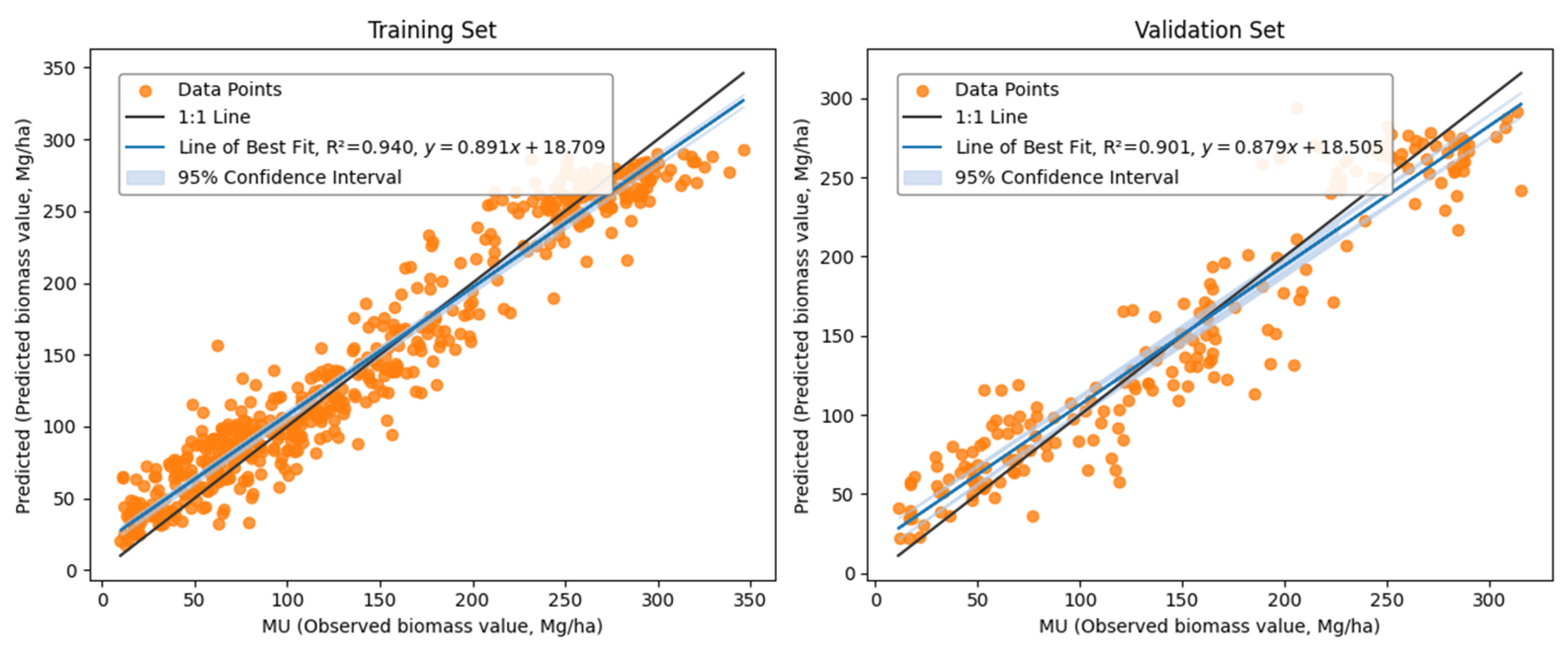
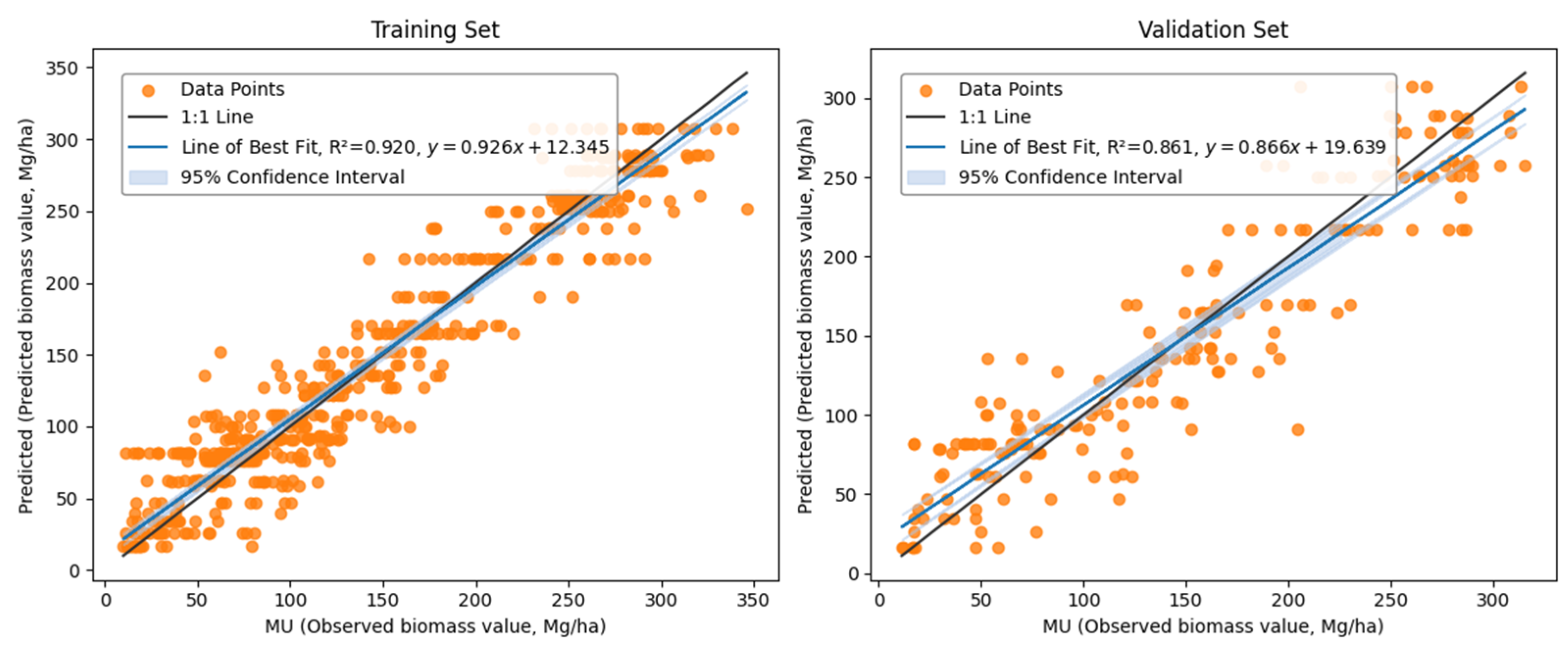

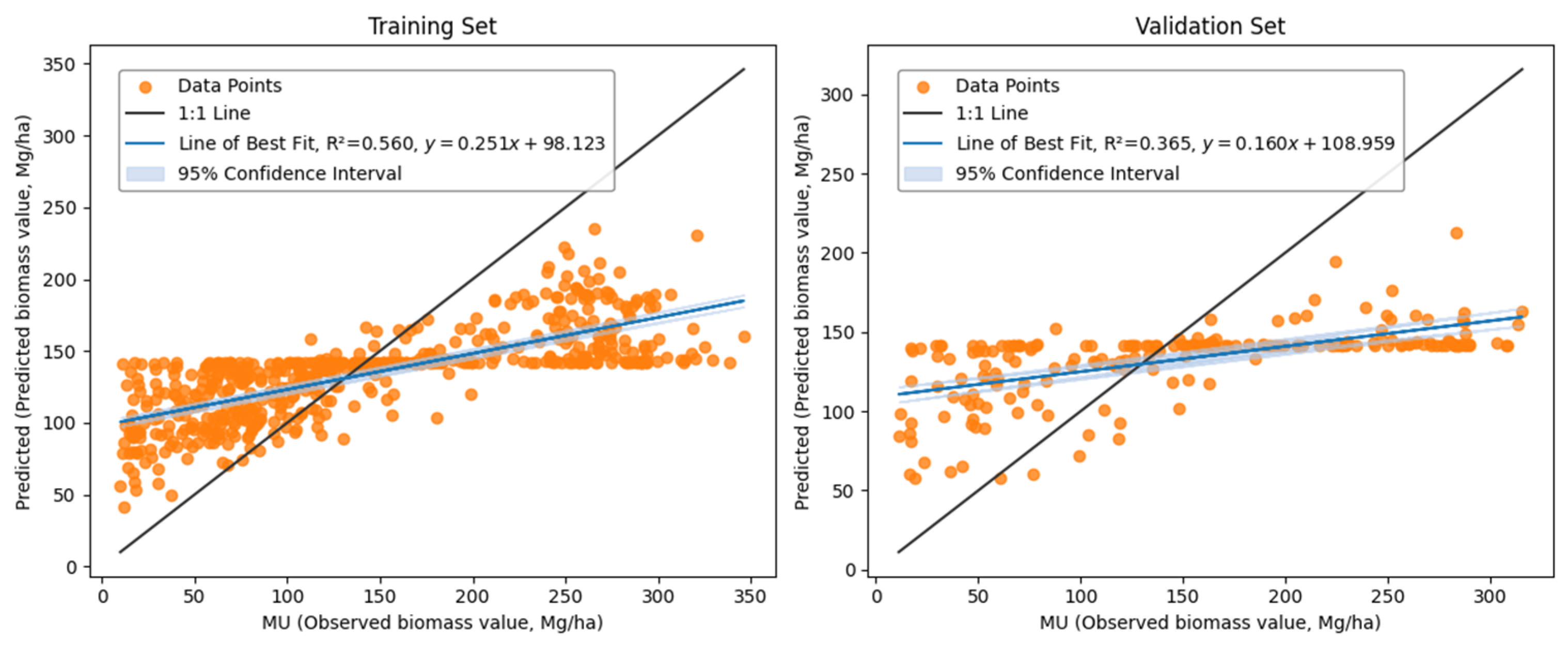


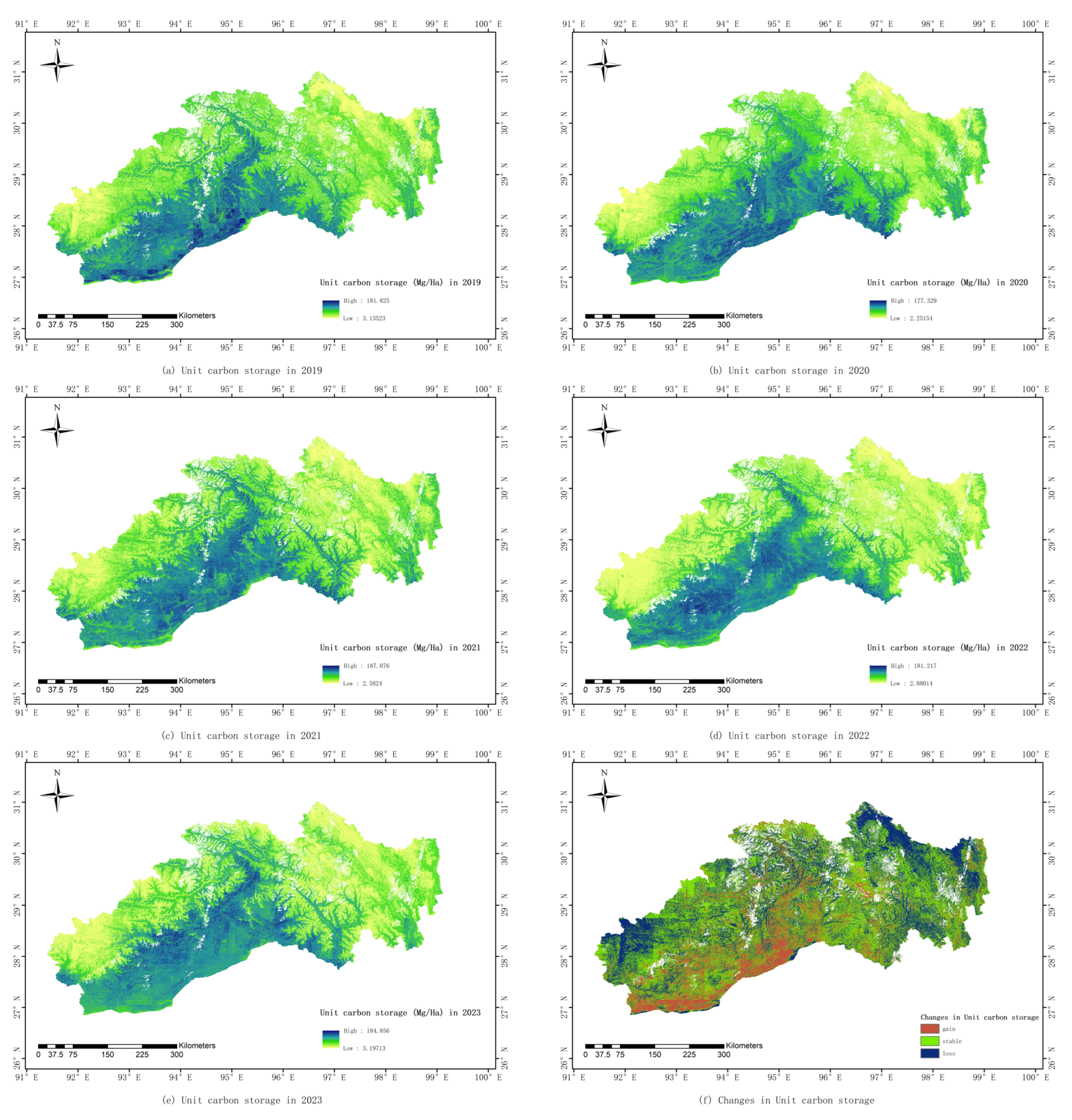
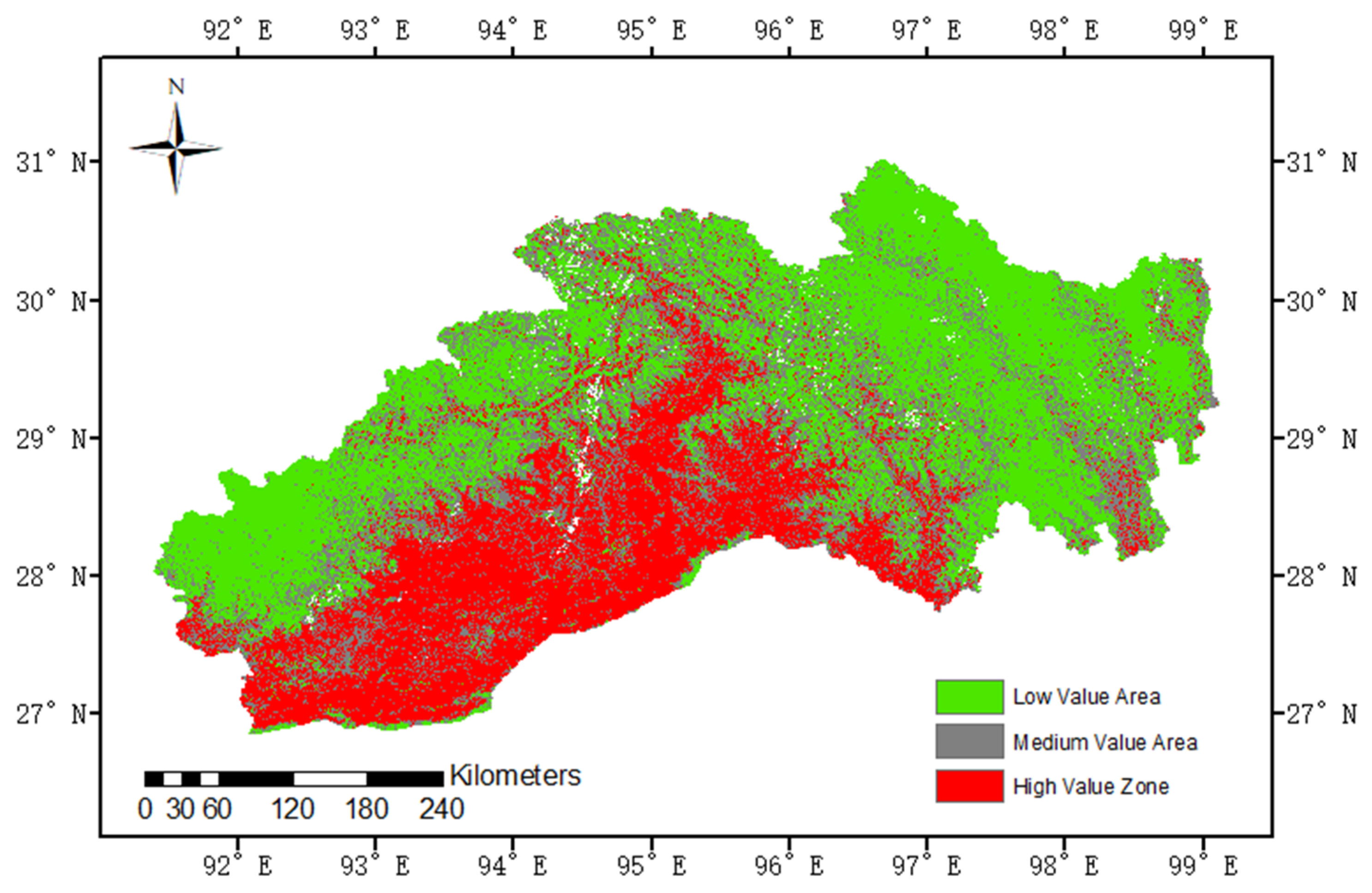
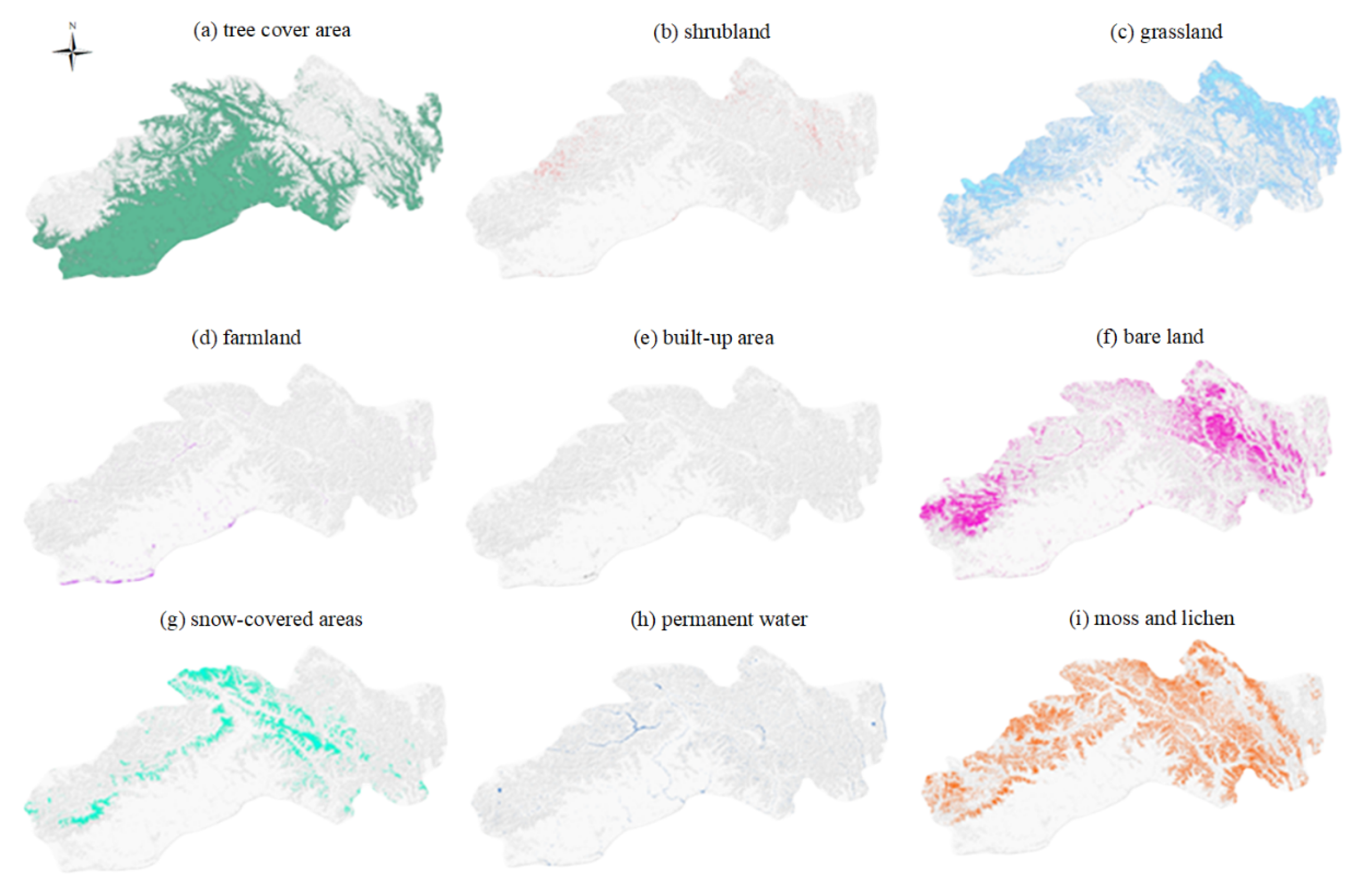
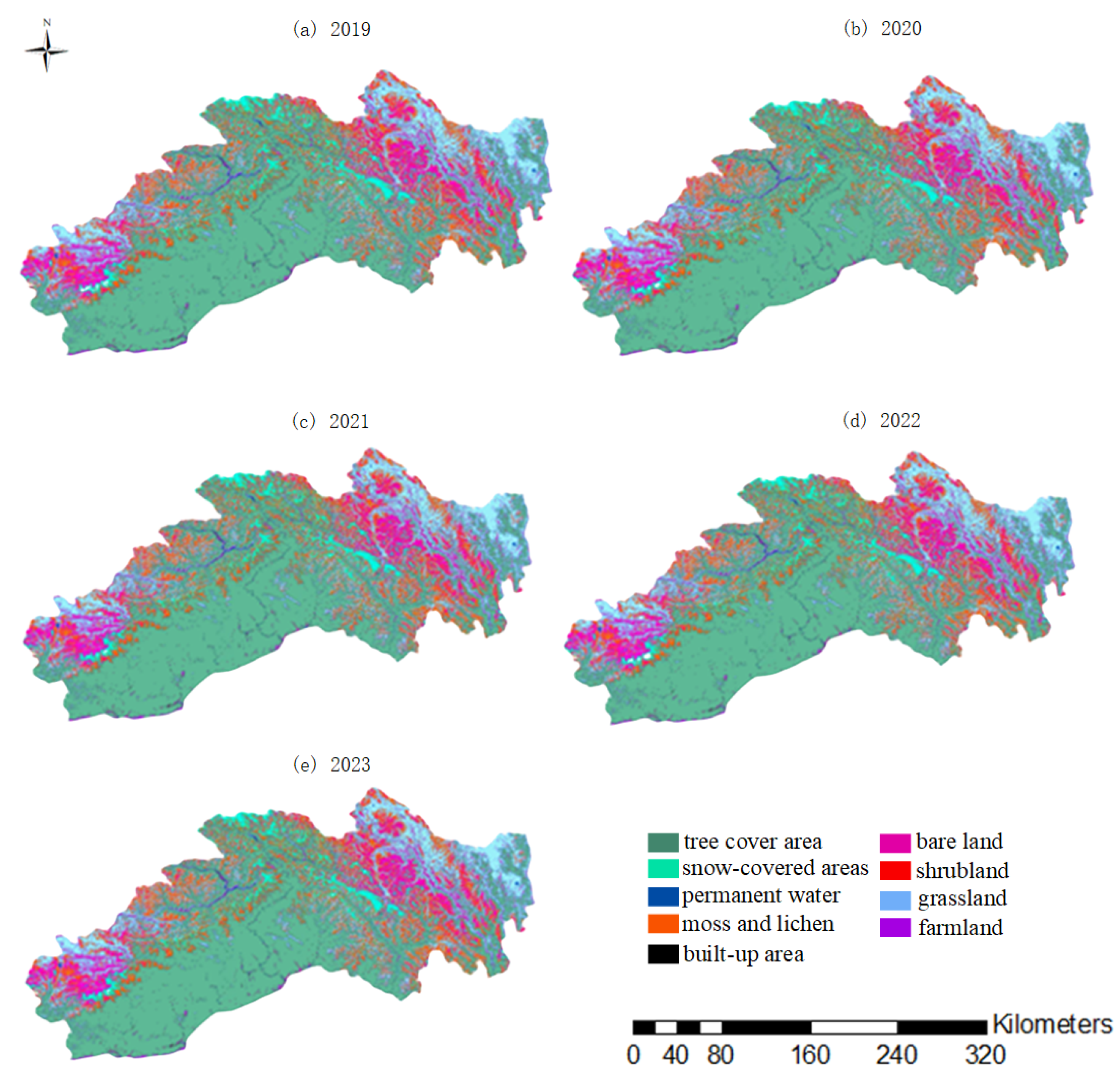
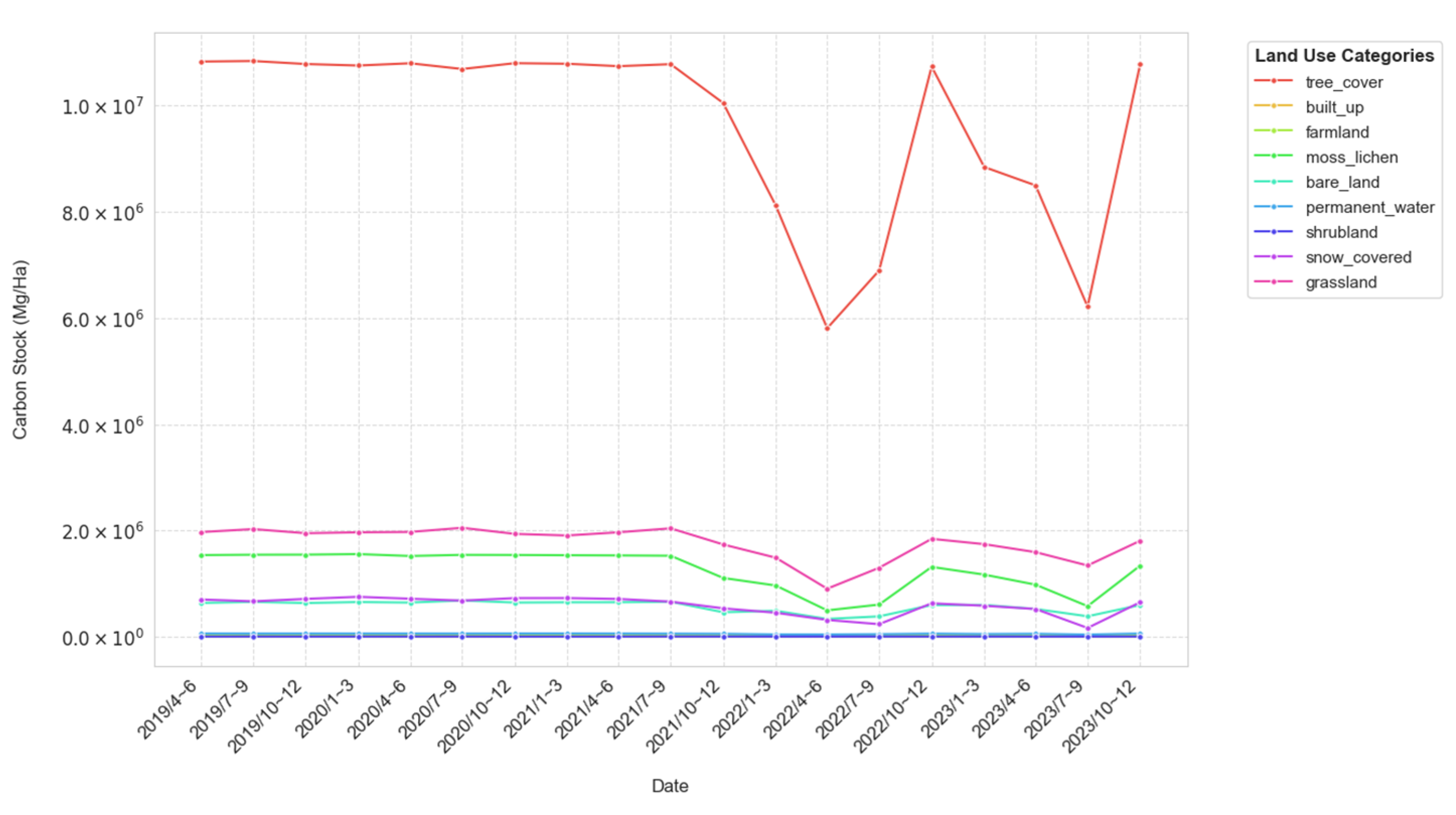
| Data and Version | Data Content | Resolution |
|---|---|---|
| Landsat 8 Collection 2 Level 2 Tier 1 | Reflectance data, atmospheric and geometric correction | 30 m |
| Sentinel-1 | Synthetic aperture radar (SAR) data | 10 m |
| ERA5 Daily Data | Temperature, precipitation, pressure, wind speed, etc. | 9000 m |
| GEDI Level 4B | LiDAR system, biomass | 1000 m |
| SRTM GL1 v003 | Elevation data | 30 m |
| ESA v100 | Global land cover map | 10 m |
| Evaluation Indicators | R2 | RMSE (Mg/Ha) | MAE (Mg/Ha) | RPD (Mg/Ha) | MAPE (%) | |
|---|---|---|---|---|---|---|
| Random Forest | Training Set | 0.940 | 22.762 | 18.030 | 4.009 | 25.789 |
| Validation Set | 0.901 | 27.799 | 21.854 | 3.166 | 26.560 | |
| CART Decision Tree | Training Set | 0.920 | 25.710 | 19.328 | 3.524 | 24.739 |
| Validation Set | 0.861 | 32.823 | 25.508 | 2.681 | 29.934 | |
| Gradient Boosting | Training Set | 0.957 | 19.336 | 15.087 | 4.753 | 21.612 |
| Validation Set | 0.909 | 26.608 | 20.302 | 3.308 | 23.626 | |
| Support Vector Machine | Training Set | 0.560 | 71.234 | 58.020 | 1.280 | 80.680 |
| Validation Set | 0.365 | 78.021 | 64.683 | 1.155 | 82.641 | |
| Date | Carbon Density (Mg/Ha) | Study Area (m2) |
|---|---|---|
| 2019/4~6 | 75.46 | 1.82 × 1011 |
| 2019/7~9 | 75.75 | 1.82 × 1011 |
| 2019/10~12 | 75.22 | 1.82 × 1011 |
| 2020/1~3 | 75.48 | 1.82 × 1011 |
| 2020/4~6 | 75.33 | 1.82 × 1011 |
| 2020/7~9 | 75.32 | 1.82 × 1011 |
| 2020/10~12 | 75.31 | 1.82 × 1011 |
| 2021/1~3 | 75.13 | 1.82 × 1011 |
| 2021/4~6 | 75.10 | 1.82 × 1011 |
| 2021/7~9 | 75.40 | 1.82 × 1011 |
| 2021/10~12 | 77.06 | 1.58 × 1011 |
| 2022/1~3 | 73.12 | 1.38 × 1011 |
| 2022/4~6 | 72.35 | 9.58 × 1010 |
| 2022/7~9 | 71.05 | 1.17 × 1011 |
| 2022/10~12 | 75.79 | 1.75 × 1011 |
| 2023/1~3 | 72.68 | 1.56 × 1011 |
| 2023/4~6 | 72.50 | 1.47 × 1011 |
| 2023/7~9 | 71.40 | 1.07 × 1011 |
| 2023/10~12 | 76.64 | 1.74 × 1011 |
| Date | Tree Cover Area (Mg/Ha) | Grassland (Mg/Ha) | Bare Land (Mg/Ha) | Moss and Lichen (Mg/Ha) | |
|---|---|---|---|---|---|
| 2019/4~6 | 10,825,898.18 | 1,972,312.96 | 639,020.41 | 1,538,898.73 | |
| 2019/7~9 | 10,836,024.28 | 2,028,491.50 | 659,046.16 | 1,545,958.08 | |
| 2019/10~12 | 10,779,628.60 | 1,950,861.47 | 637,115.40 | 1,547,470.50 | |
| 2020/1~3 | 10,751,296.34 | 1,968,002.20 | 655,532.41 | 1,557,478.03 | |
| 2020/4~6 | 10,793,722.44 | 1,974,786.93 | 645,823.47 | 1,521,998.26 | |
| 2020/7~9 | 10,685,850.11 | 2,052,525.26 | 685,247.47 | 1,543,250.54 | |
| 2020/10~12 | 10,795,310.15 | 1,938,352.72 | 646,086.74 | 1,541,154.79 | |
| 2021/1~3 | 10,784,374.29 | 1,908,254.81 | 650,782.27 | 1,536,230.22 | |
| 2021/4~6 | 10,739,138.49 | 1,968,437.78 | 651,443.55 | 1,532,525.53 | |
| 2021/7~9 | 10,776,819.99 | 2,042,477.70 | 661,259.31 | 1,526,887.50 | |
| 2021/10~12 | 10,045,654.35 | 1,739,061.64 | 462,868.64 | 1,108,598.84 | |
| 2022/1~3 | 8,117,408.88 | 1,489,891.11 | 491,115.50 | 966,456.92 | |
| 2022/4~6 | 5,807,508.51 | 906,253.94 | 337,180.44 | 498,248.04 | |
| 2022/7~9 | 6,894,336.98 | 1,299,965.37 | 385,925.06 | 607,655.09 | |
| 2022/10~12 | 10,730,775.92 | 1,844,725.16 | 598,387.25 | 1,316,321.50 | |
| 2023/1~3 | 8,841,339.32 | 1,744,769.52 | 600,574.40 | 1,171,694.32 | |
| 2023/4~6 | 8,495,046.30 | 1,593,904.99 | 524,725.60 | 982,088.93 | |
| 2023/7~9 | 6,213,510.85 | 1,343,282.32 | 387,227.06 | 578,449.27 | |
| 2023/10~12 | 10,773,944.01 | 1,808,503.07 | 598,995.93 | 1,340,219.02 | |
| Date | Snow-Covered Areas (Mg/Ha) | Shrubland (Mg/Ha) | Farmland (Mg/Ha) | Built-Up Area (Mg/Ha) | Permanent Water (Mg/Ha) |
| 2019/4~6 | 703,445.72 | 6046.24 | 37,387.52 | 3518.67 | 62,796.85 |
| 2019/7~9 | 668,936.29 | 6963.55 | 38,506.11 | 3468.91 | 61,909.22 |
| 2019/10~12 | 714,548.49 | 6130.38 | 36,454.05 | 3706.50 | 62,397.53 |
| 2020/1~3 | 753,682.68 | 6543.10 | 35,240.09 | 3458.08 | 61,926.03 |
| 2020/4~6 | 717,491.04 | 6618.97 | 35,612.61 | 3485.54 | 62,251.26 |
| 2020/7~9 | 682,566.72 | 6961.82 | 36,959.43 | 3376.23 | 61,803.60 |
| 2020/10~12 | 729,120.88 | 5660.19 | 35,201.45 | 3550.20 | 63,215.65 |
| 2021/1~3 | 730,086.59 | 5734.89 | 36,746.34 | 3546.28 | 63,412.09 |
| 2021/4~6 | 713,226.60 | 6130.17 | 36,928.61 | 3416.25 | 62,386.24 |
| 2021/7~9 | 662,958.56 | 6954.65 | 35,135.31 | 3253.16 | 60,588.88 |
| 2021/10~12 | 536,588.79 | 6343.45 | 32,646.99 | 3290.38 | 58,045.72 |
| 2022/1~3 | 454,250.07 | 5867.88 | 31,028.18 | 3031.34 | 46,440.98 |
| 2022/4~6 | 319,116.52 | 5451.07 | 35,317.23 | 3238.56 | 45,695.64 |
| 2022/7~9 | 238,724.06 | 6378.60 | 34,595.27 | 3158.64 | 50,806.85 |
| 2022/10~12 | 631,592.36 | 6434.82 | 32,733.08 | 3194.29 | 61,124.07 |
| 2023/1~3 | 585,326.12 | 6300.34 | 31,620.93 | 2921.51 | 53,606.08 |
| 2023/4~6 | 524,245.37 | 5749.91 | 33,968.21 | 3509.65 | 58,456.56 |
| 2023/7~9 | 167,647.70 | 5911.59 | 33,426.22 | 2650.58 | 43,115.36 |
| 2023/10~12 | 651,446.08 | 6511.22 | 34,482.96 | 3274.17 | 63,124.31 |
| Features | Importance Score |
|---|---|
| elevation | 22.06 |
| slope | 17.00 |
| temperature | 22.04 |
| precipitation | 9.57 |
| surface pressure | 16.79 |
| east–west wind speed | 8.53 |
| north–south wind speed | 4.02 |
Disclaimer/Publisher’s Note: The statements, opinions and data contained in all publications are solely those of the individual author(s) and contributor(s) and not of MDPI and/or the editor(s). MDPI and/or the editor(s) disclaim responsibility for any injury to people or property resulting from any ideas, methods, instructions or products referred to in the content. |
© 2025 by the authors. Licensee MDPI, Basel, Switzerland. This article is an open access article distributed under the terms and conditions of the Creative Commons Attribution (CC BY) license (https://creativecommons.org/licenses/by/4.0/).
Share and Cite
Fan, Q.; Jiang, Y.; Wang, Y.; Fan, G. Forest Carbon Storage Dynamics and Influencing Factors in Southeastern Tibet: GEE and Machine Learning Analysis. Forests 2025, 16, 825. https://doi.org/10.3390/f16050825
Fan Q, Jiang Y, Wang Y, Fan G. Forest Carbon Storage Dynamics and Influencing Factors in Southeastern Tibet: GEE and Machine Learning Analysis. Forests. 2025; 16(5):825. https://doi.org/10.3390/f16050825
Chicago/Turabian StyleFan, Qingwei, Yutong Jiang, Yuebin Wang, and Guangpeng Fan. 2025. "Forest Carbon Storage Dynamics and Influencing Factors in Southeastern Tibet: GEE and Machine Learning Analysis" Forests 16, no. 5: 825. https://doi.org/10.3390/f16050825
APA StyleFan, Q., Jiang, Y., Wang, Y., & Fan, G. (2025). Forest Carbon Storage Dynamics and Influencing Factors in Southeastern Tibet: GEE and Machine Learning Analysis. Forests, 16(5), 825. https://doi.org/10.3390/f16050825





